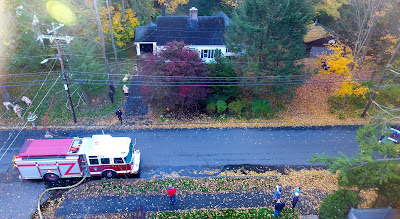Fire started on far west side of building, entered the attic, and spread to eastern side
Alpine Commons fire June 4th
When Engine 1 first arrived from Central Station on the scene of an apartment building billowing smoke and fire last month precious minutes were wasted because the only firefighter on board was the driver, who had to wait until Engine 2 arrived with an additional three person crew.
That will likely not happen again if Chief Nelson's (3/25/2016) request for eight additional firefighters is funded by a federal SAFER grant
(Staffing for
Adequate
Fire &
Emergency
Response), which funded
five additional firefighters back in 2005.
Minimum on duty staffing would go from the current 7 or 8 per shift up to ten and -- most important -- to maintain a four person engine company.
Engine 2 (the Quint) has 75' aerial ladder with 1,000 gallon per minute water nozzle
With that better staffed engine team available AFD can then meet the initial response national standard "four firefighting personnel be on scene of a fire within four minutes 80-90% of the time " rather than the current capability of meeting that target goal only 30% of the time.
And like all AFD full time professional firefighters the eight new recruits will be cross trained as paramedics or Advanced EMTs. Medical calls account for over 75% of total AFD responses.
Currently at 1.15 firefighters per 1,000 population AFD has the
lowest staffing ratio in the state for communities up to 40,000 population range and their 148.8 average calls per year per firefighter is the
highest in the state.
The current system relies on "call backs" of off-duty career firefighters and then the Call Force (paid part-timers) but with the high cost of housing in Amherst many of these personnel no longer live in town, so it takes them more time to get back here for station coverage or assisting with a structure fire.
AFD Engine 3, a 1999 pumper, seats 6 (but never sees that capacity met)
The volunteer Student Force operates out of North Station, but only when UMass is in session and they cannot staff an ambulance.
AFD protects Amherst from the ravages of fire but has for over 65 years now also contracted ambulance EMS to Leverett, Pelham, Shutesbury and Hadley. And UMass/Amherst is pretty much a city unto itself requiring both ambulance and fire protection.
Interestingly UMass has a police force
but no fire department, relying instead on
Amherst
Fire
Department, with a total budget of $4.5 million and a staff of 45 full-time firefighters.
Whereas the combined staffing of
Amherst
Police
Department and UMPD is 107 full-time police officers and a combined budget of $10.5 million (half paid by state and other half town funded).
UMass has over 100 buildings, include five 22 story high rise dormitories
Better AFD staffing would also cut down on mutual aid ambulances needed every year, which averaged 78 per year for the past three years.
Mutual aid ambulances take longer to get here (the closest professional mutual aid partner is 10 miles away with an average response of 12 minutes), and the town losses the $1,000 average billing per call, or $78,000 per year.
Call backs for "station coverage" which now cost between $15 - $20,000 per year would be dramatically reduced as would annual overtime costs of $248,000 or Call Force costs of $75,000.
The SAFER grant would pay all expenses for the eight new personnel for two full years at a cost of a little over $500,000 per year. Then it would be the town's responsibility to cover employee costs, but there is no requirement to keep all (or any) of the eight firefighters.
That way we have two years to figure out if the additional increase in people power pays for itself.
Although it's hard to put a price on saving a life.











































































